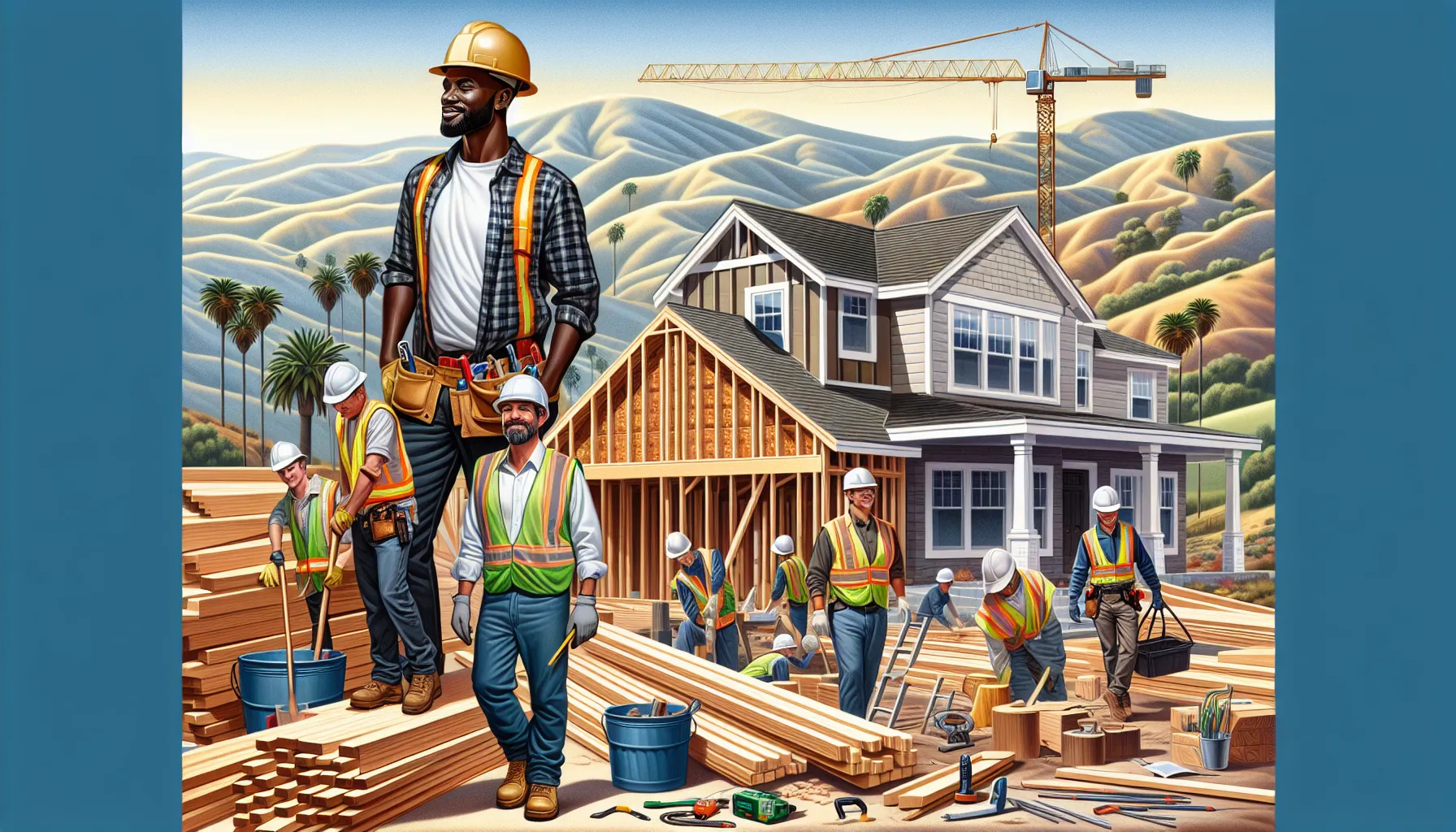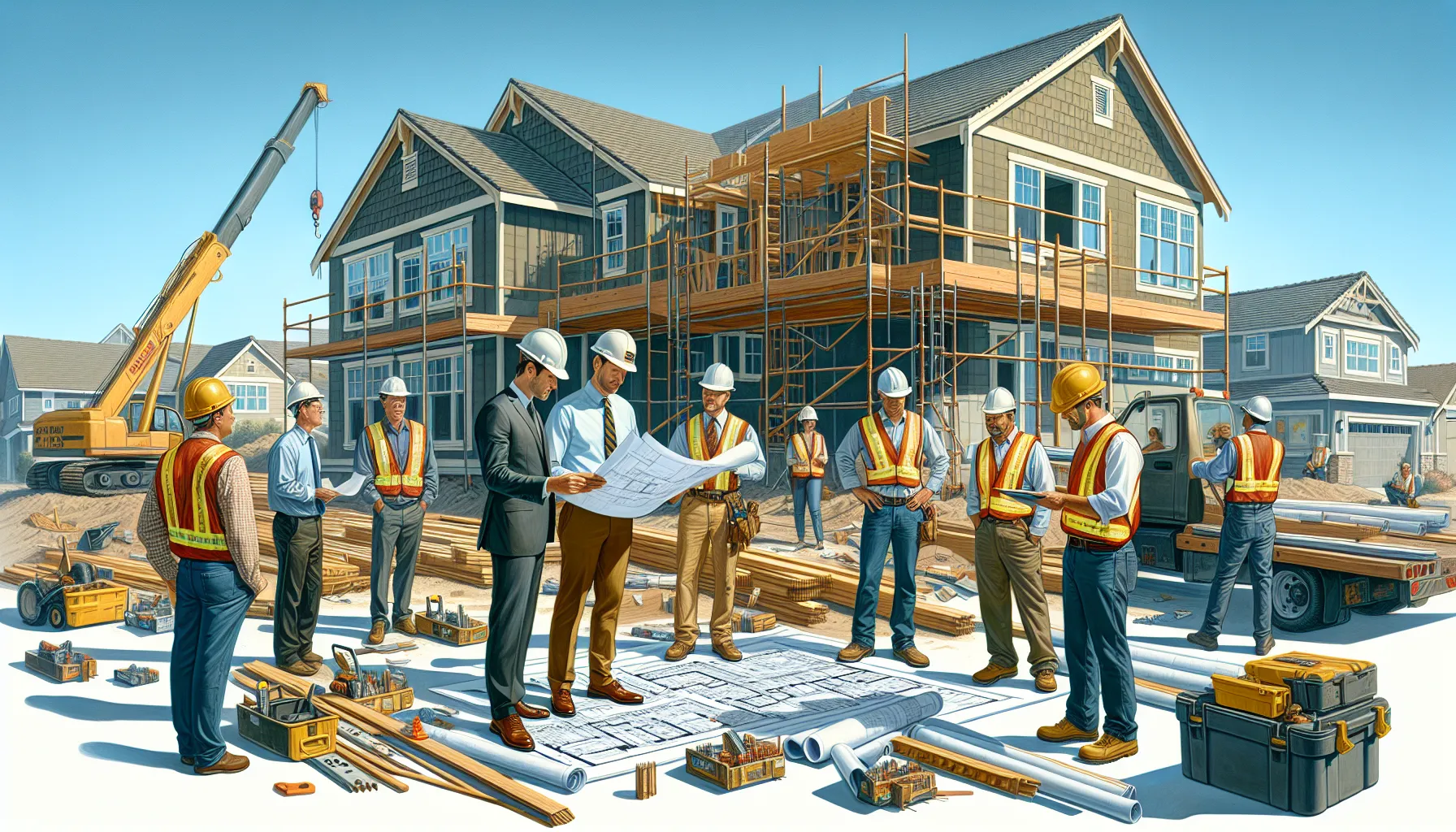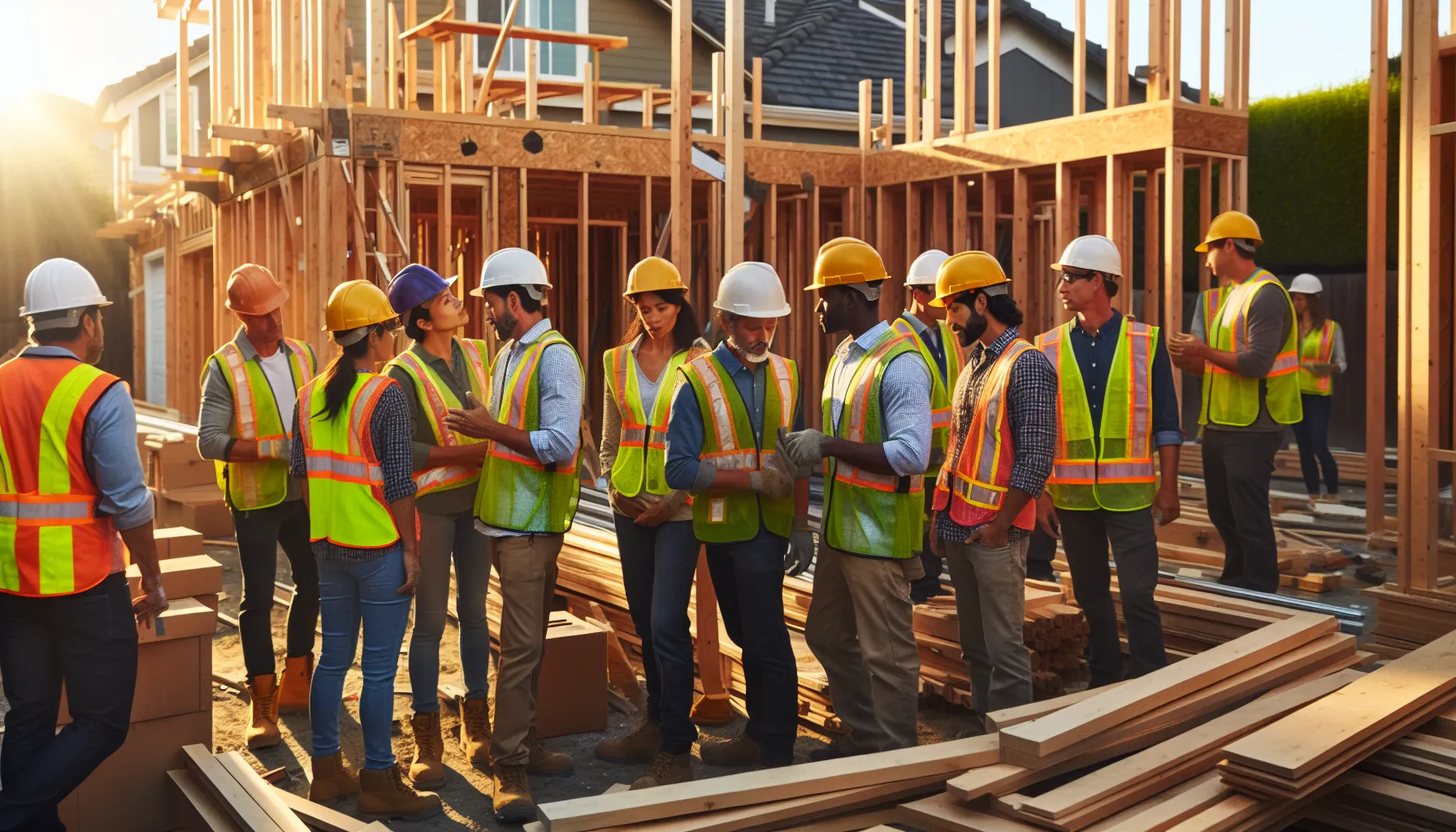Key Takeaways
- Average Construction Costs: In California, building a house in 2024 ranges from $300 to $600 per square foot, varying significantly by location and design complexity.
- Land Prices: Urban areas like San Francisco and Los Angeles have soaring land prices ($150 to over $500 per square foot), while rural areas can offer more affordable options (as low as $30 per square foot).
- Labor Expenses: Labor costs are a significant part of the budget, averaging $25 to $60 per hour, influenced by skilled labor shortages and varying demand across regions.
- Material Costs: Material prices can fluctuate due to market conditions, with a focus on choosing sustainable options for long-term benefits despite possible higher initial costs.
- Regulatory Impact: California’s strict building codes and permitting fees can extend project timelines and impact overall costs, adding an additional 10% to 25% to budgets.
- Financing Options: Various financing choices, including traditional mortgages, construction loans, and state programs, are available to help with rising costs while considering the long-term return on investment.
Building a house in California is a dream for many, but it comes with a hefty price tag. As we dive into 2024, understanding the costs involved can help us navigate the complexities of home construction in this diverse state. From land prices to labor and materials, every aspect influences our budget and timeline.
With California’s unique market conditions and regulatory environment, we need to be prepared for surprises along the way. Whether we’re looking to build a cozy bungalow or a sprawling estate, knowing the financial landscape can make all the difference. Join us as we break down the essential costs and provide insights to help us make informed decisions in our home-building journey.
Overview of House Construction Costs in California (2024)
Understanding house construction costs in California for 2024 requires a comprehensive analysis of various factors, including land prices, labor expenses, and material costs. The average cost to build a house in California currently ranges from $300 to $500 per square foot. These figures vary significantly based on location, design complexity, and materials chosen. For example, homes in urban areas like San Francisco and Los Angeles tend to have higher costs due to increased demand and limited land availability.
Labor costs in California also play a crucial role in the construction budget. Skilled labor shortages lead to higher wages, averaging around $25 to $60 per hour for various trades such as carpentry, plumbing, and electrical work. With the ongoing demand for new housing, these costs are expected to rise. Additionally, contractors often account for project management fees, which can add another 10% to 20% to the total labor expense.
Material prices fluctuate based on market conditions and are influenced by factors like transportation costs and tariffs. For instance, wood and steel prices have seen substantial increases due to supply chain issues and global demand. In 2024, purchasing sustainable or higher-quality materials may result in upfront savings, as they often yield long-term benefits in energy efficiency and maintenance.
Local regulations and permitting fees further impact construction costs. California has some of the strictest building codes in the country, which can extend project timelines and increase costs. The permitting process may incur fees ranging from a few hundred to several thousand dollars, depending on the project’s scope and location.
As we navigate the complexities of house construction costs in California, it’s important to factor in these variables to develop a realistic budget. Reflecting on competing priorities—like cost versus quality—can significantly influence decision-making in our home-building journey. By thoroughly researching and anticipating potential expenses, we position ourselves to make informed choices, ensuring a smoother construction process in California’s challenging market.
Factors Influencing Building Costs

Understanding the various factors influencing building costs is crucial for anyone planning to build a home in California. Each element affects the overall budget, so being informed helps us make better decisions.
Land Prices
Land prices fluctuate based on location, size, and zoning. In urban areas like San Francisco and Los Angeles, prices soar due to high demand and limited availability. For example, land prices can range from $150 to over $500 per square foot in these markets. Conversely, rural areas may offer more reasonable pricing, sometimes as low as $30 per square foot. Additionally, factors such as proximity to amenities and public transport can significantly impact land prices. Building on a desirable lot often leads to higher initial costs, but may enhance long-term property value. Understanding these dynamics allows us to assess which locations meet both our budget and lifestyle needs.
Material Costs
Material costs significantly influence the overall construction budget. Fluctuations stem from market conditions, economic trends, and supply chain issues. For instance, lumber prices recently soared due to pandemic-related supply constraints, sometimes reaching $1,500 for a single thousand board feet. Similarly, the costs of concrete and steel see regular changes based on factors like tariffs and international demand. Choosing sustainable materials could lead to higher upfront expenses, but they often provide energy savings and durability over time. By weighing the pros and cons of different materials, we can find options that balance quality and affordability.
Labor Expenses
Labor expenses play a critical role in determining overall building costs. The current demand for skilled labor in California has driven hourly wages up to $60 for electricians and plumbers. Additionally, skilled trades may command up to $25 per hour, influenced by labor shortages. Beyond wages, project management fees can contribute an additional 10% to 20% to total labor costs. Understanding these figures allows us to budget more accurately and plan for potential cost overruns during the construction process. By engaging reliable contractors and skilled workers, we can manage labor expenses effectively while maintaining quality.
Average Costs by Region

Building costs in California vary significantly by region, influenced by factors like land prices, labor availability, and local regulations. Understanding these regional differences can help us make informed decisions when planning our construction budgets.
Northern California
Northern California generally experiences higher construction costs compared to other regions, particularly around the San Francisco Bay Area. We notice average costs ranging from $400 to $600 per square foot for new builds. Factors like high demand, limited land supply, and strict building regulations contribute to these elevated prices. Labor costs here also reflect the region’s economic landscape, with tradespeople earning between $30 and $80 per hour, given the competitive market. Additionally, urban areas often add permitting fees that can escalate project costs by 10% to 25%. For example, San Francisco’s rigorous codes can extend project timelines and budgets substantially.
Southern California
Southern California offers a diverse range of building costs, with average expenses between $300 and $500 per square foot. Areas like Los Angeles and Orange County tend to be on the higher end, driven by demand and land scarcity. Conversely, regions further inland, such as Riverside and San Bernardino, present more affordable options. Labor rates in Southern California range from $25 to $65 per hour, influenced by experience and specialization. We also see that permitting fees fluctuate, affecting construction timelines, often adding 5% to 15% to the overall cost. Local regulations can impact material selection too, as sustainable builds are encouraged but may carry higher initial expenses.
Cost Breakdown for Different Home Types
Understanding the costs associated with different home types in California helps us budget effectively. Each home type comes with unique expenses that impact the overall cost of building.
Single-Family Homes
Single-family homes typically range from $300 to $600 per square foot, depending on location and amenities. Urban regions like San Francisco and Los Angeles generally push costs towards the higher end due to land scarcity and higher demand. For instance, in desirable neighborhoods, land acquisition can exceed $500 per square foot, while construction materials and labor further inflate the total cost. Builders also incur additional expenses like landscaping, permits, and utility connections, which often add 10% to 20% to the project cost. Knowing these specifics enables us to plan accurately and avoid unexpected financial burdens.
Multi-Family Units
Multi-family units usually present a different cost structure, averaging between $250 and $400 per square foot. The pricing variations depend largely on the number of units and location. Higher-density areas attract higher costs, while suburban locations may offer more affordable options. Labor costs for multi-family construction also increase, as projects require more extensive management and coordination among tradespeople. Additionally, shared amenities like pools or gyms add to overall expenses, potentially raising costs by 15% or more. Recognizing these factors allows us to align our investment strategies with projected returns, ensuring our projects remain profitable.
Financing Options for Home Builders
Understanding financing options is crucial for home builders in California, especially as costs continue to rise. Traditional mortgages remain a primary choice for many, offering various programs including fixed-rate and adjustable-rate loans. Fixed-rate mortgages provide stability with predictable payments, while adjustable-rate mortgages may offer lower initial rates but introduce future variability. Builders can explore options like FHA loans or VA loans, which often feature lower down payment requirements and favorable terms for eligible applicants.
Construction loans serve as another viable option, specifically tailored to cover the building phase. These short-term loans typically convert into permanent mortgages once construction finishes. Construction loans can reduce the need for out-of-pocket expenses during the building process, making them appealing for many builders. We advise reviewing terms carefully, as lenders often set stringent criteria regarding budget management and completion timelines.
We also recommend considering personal loans for smaller projects or renovations. While usually carrying higher interest rates compared to traditional mortgages, personal loans offer flexibility and quick access to funds without the extensive underwriting process common in mortgage applications. This option can be particularly beneficial for covering unforeseen costs during construction.
In addition, we encourage exploring state and local programs that provide financial assistance or grants for home building. Certain California programs aim at promoting energy efficiency or affordable housing, offering incentives such as tax credits or reduced interest rates. Checking for eligibility can uncover valuable resources that ease financial burden.
As you navigate these financing options, reflecting on the overall cost versus anticipated return on investment becomes crucial. Each financing choice holds its own benefits and trade-offs, influencing budget management, cash flow, and long-term financial health. Thoughtfully weighing these aspects ensures we align our financing strategy with our broader building goals.
Conclusion
Building a house in California in 2024 presents both challenges and opportunities. With costs varying significantly across regions and influenced by factors like labor and materials, it’s essential for us to approach this journey equipped with knowledge.
By understanding the unique dynamics of our chosen location and carefully planning our budgets, we can navigate the complexities of construction. As we consider financing options and project management strategies, we’ll be better positioned to achieve our dream home while maximizing our investment. Embracing thorough research and anticipating potential expenses will lead to a smoother building experience in California’s ever-evolving market.
Frequently Asked Questions
What are the average costs to build a house in California as of 2024?
The average cost to build a house in California ranges from $300 to $500 per square foot. Costs can vary significantly based on location, design complexity, and material choices. For instance, urban areas like San Francisco and Los Angeles tend to be on the higher end due to demand and land scarcity.
How do labor costs affect home construction in California?
Labor costs in California are an essential part of the construction budget, with skilled labor typically ranging from $25 to $60 per hour. Due to labor shortages, these rates may increase, adding further expenses to your total building costs.
What additional expenses should I consider when building a house?
When building a house, you should budget for additional expenses such as landscaping, permits, and utility connections, which can increase the project cost by 10% to 20%. Understanding these factors helps in managing the overall budget effectively.
How do local regulations influence construction costs in California?
Local regulations and permitting fees in California can significantly impact both costs and project timelines. Strict building codes and lengthy permitting processes can extend the time needed to complete your project, leading to increased expenses.
What is the cost breakdown for different types of homes?
Single-family homes in California typically range from $300 to $600 per square foot, while multi-family units average between $250 and $400 per square foot. Factors such as location and unit number can heavily influence these averages.
What financing options are available for home builders in California?
Builders in California can consider various financing options, including traditional mortgages, construction loans, and personal loans. Each option has its benefits and drawbacks, so it’s essential to choose one that aligns with your budget and goals.
Why are construction costs higher in Northern California?
Northern California generally experiences higher construction costs, particularly in areas like the San Francisco Bay Area. Factors such as high demand, limited land supply, and strict building regulations all contribute to these elevated prices.
How can I find financial assistance for home building projects?
Exploring state and local programs that provide financial assistance or grants can be beneficial, especially those aimed at promoting energy efficiency or affordable housing. Researching these options can help offset building costs.






